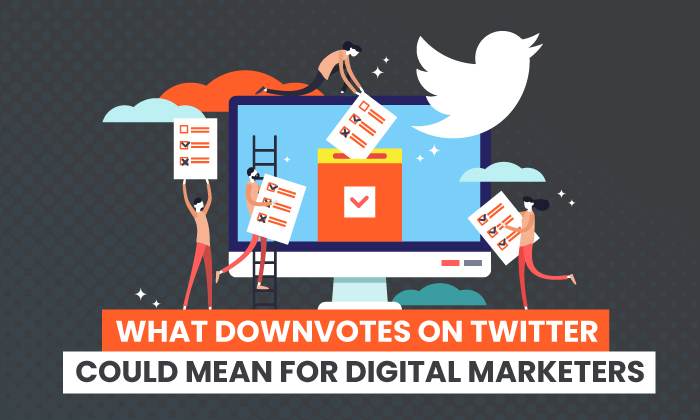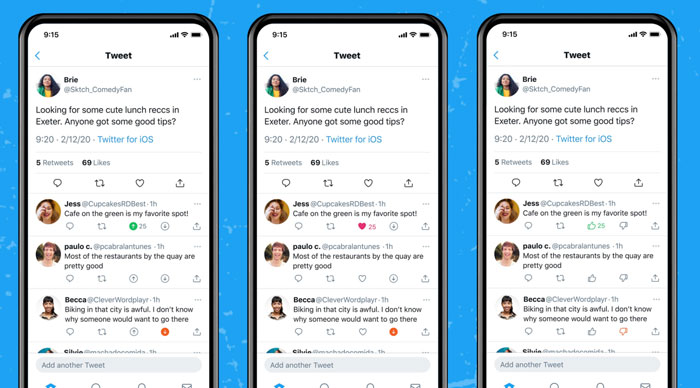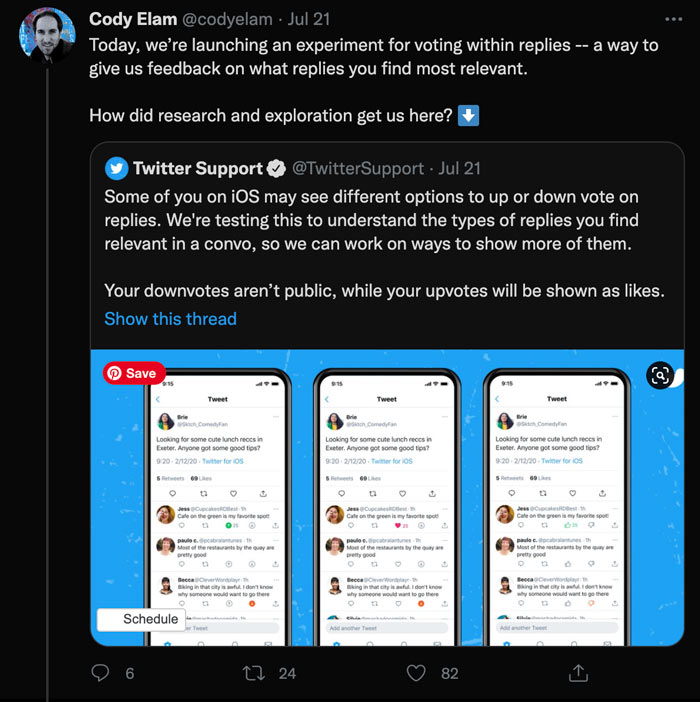
Twitter’s “toxicity” is a sore spot for many users and brands.
Could its newest potential feature be a way to help the platform become a more positive place for everyone?
Yes and no: Downvotes can alert the algorithm to spam, but trolls can abuse it to squash useful information.
That’s only the tip of the iceberg.
Here’s what downvotes on Twitter could mean for digital marketers and how you can prepare.
Twitter Downvotes: What You Need to Know
On June 21, Twitter sent out a tweet that sent the social media world into a frenzy.
“Some of you on iOS may see different options to up or down vote on replies. We’re testing this to understand the types of replies you find relevant in a convo, so we can work on ways to show more of them.”
What does this mean?
Twitter is toying with the idea of introducing a feature similar to Reddit’s upvoting and downvoting system.
iOS users part of the test will see thumbs up and thumbs down icons, while others will see arrows pointing up or down.

It sounds similar to the “like” button. Right?
However, there is a twist. Your downvotes are private, and the votes don’t change the order of replies.
What does Twitter hope to gain from this experiment? Cody Elam, a user researcher at Twitter, sent off a bunch of Tweets explaining the social media platform’s thought process.
“In past research, we’ve learned which types of replies are considered best when reading conversations: Informative, supportive, positive, and funny. But some of the best replies don’t always surface quickly enough.
We’re testing a few approaches to allow people to upvote and downvote replies. This gives people the power to privately voice their opinion on the quality of replies without publicly shaming others while also giving us more nuanced feedback.”

What Are Downvotes on Social Media?
Okay, let’s back up a bit.
You’re probably wondering, “What are downvotes on social media, and how are they useful to my experience with these platforms?”
On Reddit (a massive online forum where people can share and comment on content), users can vote for topics or replies to questions to help boost the most relevant content and trends.
For example:
- Think someone’s comment answers the OP’s query the best? Hit the thumbs-up button to boost it higher.
- Think another user’s reply is spammy or a troll? Click the thumbs-down button to move it further down the page.
With an average of 830,000 posts a day, the site doesn’t solely rely on the algorithm to keep users entertained. The voting system democratizes the process and helps people discover a range of interesting content and key trends.
The human element is something Facebook, Instagram, and Twitter can’t compete with because the sites rely on an algorithm to show you more of the same content you like.
With up and downvoting on Reddit, you’ll see topics you haven’t registered a previous interest in simply because it’s trending.
Simply put, it gives you a way to uncover new ideas, find entertaining content, and discover informative posts. This is something Twitter wants to bring onto its platform but can’t rely on its AI to bring to life.
4 Ways Twitter Downvotes Could Impact Digital Marketing
Nothing is officially rolling out, but curiosity is piqued.
I’ve seen a lot of conversations around how this new feature will change the Twitter landscape for digital marketers. Here are my predictions, the good, the bad, and how we can prepare.
1. See Opinions on Ads, Brand Messaging, and Product Development
At the moment, we can only measure the impact of our ads through analytics like click-through rate (CTR) and the total amount of sales.
The downvote button gives us another tool in our digital marketing toolbox.
If an ad gets a high number of downvotes, your audience is telling you it’s a hard pass. This allows you to revisit the creative, adjust your copy, and try again.
Over time, you’ll learn what your audience likes best, create better ads, and see a higher conversion rate.
You can apply the same logic to brand messaging and product development. It’s another way to get inside users’ heads and deliver something you know they’ll like rather than throwing up anything and hoping something will stick.
For example, let’s say you’re running a sustainable activewear brand. You want to launch your next collection, but you’re not sure which trending color your audience likes best: french blue or rust.
You could create two tweets with the color swatch and ask users to downvote their least favorite.
The best part? Your competitors and followers won’t see a clear winner. When you launch, there’s still an element of surprise.
2. Better Understand Brand Sentiment
One of the biggest concerns for digital marketers is brand sentiment. It’s why we invest in social listening tools to discover conversations about our brands and step in before problems get out of control.
Keeping an eye on brand sentiment helps:
- respond to urgent queries quickly
- monitor marketing efforts and campaign reactions
- avoid negative PR
- know where your brand stands on a day-to-day basis
The downvote button on Twitter is another tool to gauge your brand image.
If a post is heavily downvoted or upvoted, it’s a clear indication of how people feel about you.
- Is it positive? That’s great! You know you’re on the right path.
- Is it negative? You know there’s work to be done, and it’s time to switch gears.
BetterHelp, an app for therapy, went through a massive controversy a few years ago. If that happened with a feature like this, the brand might find all their replies getting bombed by downvotes.
While other users won’t see this slew of negative sentiment (unless they read the comments), it could affect their reach and ability to engage in conversations on the platform.
3. Leverage Private Voting
A potential usage of up and downvotes that I’m really excited about is private voting.
Sure, there are public polls on Twitter, but encouraging people to use those buttons could potentially affect your engagement.
Think about it. Twitter is trialing this new feature because it wants to help users find more interesting, entertaining, and relevant conversations. You can use this to your advantage by encouraging people to “vote” with a strong call to action (CTA).
For example, you could post something light-hearted like “complete this sentence” and use a CTA like “up or downvote your favorite replies.”
The result? More people will interact with your post, boosting your engagement, and Twitter’s algorithm will get the signals it needs to push it out to more feeds.
The more eyes on your tweets, the more potential followers and sales you can make.
Cha-ching.
4. Self-Moderate Posts
Another potential use that will benefit brands and users is the ability to self-moderate.
Let’s say a reply receives too many downvotes. Twitter could push that tweet detracting from the conversation down further or hide it completely.
In essence, this gives users the ability to self-moderate their communities. It also saves social media managers from spending time manually hiding replies (which is a feature you can use on Twitter right now).
As with most things on the internet, this does come with a few negatives. Trolls could target a user and hide potentially useful information on purpose. For example, people could upvote vaccine conspiracy theories and downvote scientific papers that disprove those arguments.
On the other hand, it could be a way to improve the reach of misinformation. If users mass downvote harmful conspiracy theories, Twitter will hide it, and fewer people will be misled.
Frequently Asked Questions About Twitter Downvotes
What is a downvote on Twitter?
A downvote is a voting system that helps the algorithm understand what tweets users find the most engaging, informative, and entertaining.
How are upvotes and downvotes useful on social media?
- Upvotes and downvotes are useful on social media because it allows people to voice their opinions. People can see at a glance if someone disagrees with a statement, and it can help people find new content other users are enjoying.
When will Twitter launch downvotes?
It is unclear if and when Twitter will roll out downvotes to all users.
How will Twitter use downvotes?
Twitter plans to use downvotes to better understand what conversations users find the most important, engaging, and informative, help people discover these tweets faster, and filter out spam and abusive replies.
Twitter Downvotes: Conclusion
At the moment, it’s too early to say for certain if downvotes on Twitter will be a good or bad thing for digital marketers and if it will help solve the platform’s “toxic” reputation.
However, I think there is potential, and democratizing the content could give it a competitive edge over Facebook and Instagram.
I’m interested to see how users interact with the feature and if Twitter plans to implement anything else to combat the potential for abuse.
What do you think of Twitter testing out a downvoting system on the platform?
from Blog – Neil Patel https://ift.tt/3lOJGTz
via IFTTT
No comments:
Post a Comment